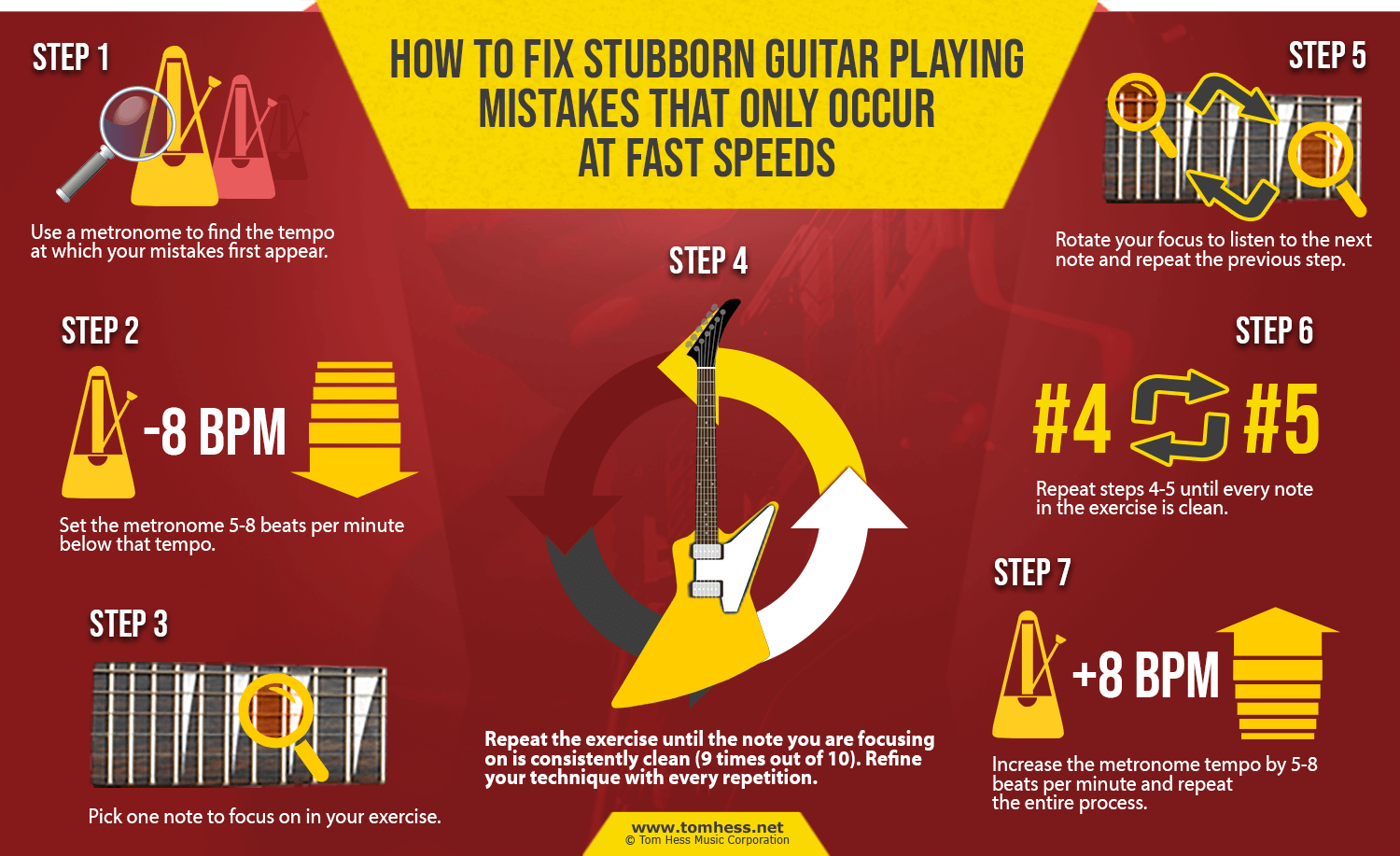Unusual Arpeggio Patterns – Cool Arpeggio Licks For Guitar

EMAIL TO GET ACCESS
By submitting your info, you agree to send it to Tom Hess Music Corporation who will process and use it according to their privacy policy.
If you like playing guitar arpeggios, but find regular sweep picking guitar arpeggio kind of boring...
... then this article will show you unusual arpeggio patterns that will help you create cool new rock guitar licks.
Heads up:
These arpeggio licks for guitar are not meant to play guitar fast.
That said...
Unlike your typical sweep picking arpeggio licks for guitar...
(that ‘only’ sound cool if you play them fast)...
You don’t need to play *these* guitar arpeggios fast to make them sound AWESOME.

EMAIL TO GET ACCESS
By submitting your info, you agree to send it to Tom Hess Music Corporation who will process and use it according to their privacy policy.
Which means:
You can create cool rock guitar licks and sound pro with them starting today.
(And you can do it even if you aren’t an advanced guitar player yet.)
Ready to start?
Watch this video to learn the unusual arpeggio patterns I'm talking about and then use the tips below to take your arpeggio playing to the next level:
Now that you know how to play arpeggio licks for guitar using 2 notes per string...
... here are 5 more tips for creating rock guitar licks using guitar arpeggios.
Unusual Arpeggio Patterns Tip #1 Create Rock Guitar Licks Using Variations OF Familiar Guitar Arpeggios
You can play unusual arpeggio patterns (and create cool rock guitar licks) even with conventional sweep picking patterns.
“How”, you ask?
It can be as simple as playing only descending sweep picking patterns (play arpeggio licks for guitar from the highest pitch down to the lowest pitch). This alone not only helps you come up with cooler guitar arpeggios (and rock guitar licks), but is a good exercise for your guitar technique too.
Question: “Tom Hess, should I play the lowest note in my arpeggios for guitar with an upstroke or a downstroke when sweep picking descending only?”
Answer: Use an upstroke. Here is why: when playing arpeggios for guitar descending only, you need to pretend you’ll be sweep picking on another string (as you would if you made your guitar arpeggios longer). Thus, the picking motion should reflect that.
You can also do the opposite and play guitar arpeggios ascending only. This is the opposite of the rock guitar licks in the previous idea, as you’ll be playing the arpeggio from the lowest pitch up to the highest pitch.
Another idea is to put musical rests after the highest note in each of your guitar arpeggios. This creates a lot of musical tension in your arpeggios for guitar (and makes it sound like you are playing some unusual arpeggio patterns, even when you are not).
Silence is a very powerful tension builder in music in general (whether you are playing rock guitar licks or licks in any other style).
You can also mix up the number of strings you are playing: creating guitar arpeggios on 2 strings, 3 strings, 4 strings, 5 strings, 6 strings (or more strings if your guitar has them). Jeff Loomis is famous for playing arpeggio licks for guitar using this idea. And his guitar solos use some of the most unusual arpeggio patterns you’ll ever hear.
This video shows how cool these ideas sound:
As a bonus:
Combine the above ideas to create cool arpeggios for guitar and rock guitar licks you won’t hear many guitarists play.
Unusual Arpeggio Patterns Tip #2: Combine Arpeggios With Tremolo Picking
This is one of my favorite ways to insert bursts of fast playing into my arpeggio licks for guitar (without actually playing all that fast or doing anything very advanced).
All you do is stop on any note in the middle of an arpeggio and tremolo pick it. (You can do this with any and all arpeggios for guitar that you know.) This makes your playing sound fast and aggressive, but is very simple for both hands to play.
Question: “Tom Hess, how many times should I tremolo pick the note I stop on in these guitar arpeggios?”
Answer: It doesn't matter at all how many times you tremolo pick the note. Go entirely by feel here and don't count every single pick stroke.
On top of helping you sound fast, this idea gives you nearly endless possibilities for awesome rock guitar licks. That’s especially if you practice doing this on all sweep picking shapes you know and vary which notes you apply tremolo picking to.
Playing arpeggios for guitar with tremolo is also a great way to see how clean your guitar arpeggios are and how well you can keep your hands in sync when playing unusual arpeggio patterns.
Here is what I mean: when you can stop on any note in your guitar arpeggios with tremolo and have it be clean – it is proof that your guitar arpeggios sound very clean and pro.
Question: “Tom Hess, should I practice this drill with distortion or a clean tone?”
Answer: It depends on your goal. When it comes to using this idea as part of your rock guitar licks – you can use any sound to combine arpeggios for guitar with tremolo.
But if you are practicing to improve your technique with guitar arpeggios, then use distortion when playing your arpeggio licks for guitar. The reason? Distortion compresses the sound of the notes and makes any mistake very loud.
That forces you to fix it and makes your playing cleaner (so your rock guitar licks sound better).
Want to see and hear how cool arpeggio licks for guitar sound when you combine (sweep picking) guitar arpeggios with tremolo?
Watch this video:
Unusual Arpeggio Patterns Tip #3: Use Speed Bursts When Playing Arpeggio Licks For Guitar
Most of the ideas for playing rock guitar licks we covered so far in this guitar arpeggios article don’t require you to sweep pick fast.
But if you want to play fast arpeggios for guitar with sweep picking (and create unusual arpeggio patterns to add to your rock guitar licks)...
 How To Play Awesome Guitar Riffs
How To Play Awesome Guitar RiffsFind out how to play killer rhythm
guitar riffs in a rock/metal style.
 10 Ways To Improve As A Guitarist
10 Ways To Improve As A GuitaristLearn 10 things that will help you quickly become a better guitarist.
 Learn What To Practice On Guitar
Learn What To Practice On GuitarLearn how to become a balanced
guitarist and fix your weaknesses.
... then speed bursts are the way to go.
What are speed bursts?
It is a simple (but little-known) way to increase your guitar speed with all rock guitar licks you play. This includes both playing guitar arpeggios with sweep picking and the unusual arpeggio patterns you learned in this article.
Speed bursts help you break through speed plateaus without doing much (or any) slow guitar practice.
And no, I don’t mean to say that slow guitar practice is bad.
But slow guitar practice does have its problems.
For one thing: slow guitar practice can get pretty boring.
Secondly: many mistakes only happen when you start to play guitar fast. And when you do slow guitar practice, they disappear.
That means much of your guitar practice time is wasted (since you don't spend any of it focused on the mistakes you need to be correcting).
But with speed bursts, you get to focus on the exact obstacles to your guitar speed and fix them quickly.
In addition, you can use speed bursts to create guitar arpeggios that sound awesome in your rock guitar licks and guitar solos.
This video shows you how to play guitar arpeggios (and other rock guitar licks) using speed bursts:
Aa a bonus, check out this guitar practice circuit (that you can use with rock guitar licks based on guitar arpeggios, as well as all other techniques) that helps you fix mistakes that only happen at your maximum speeds.

Unusual Arpeggio Patterns Tip #4 Use Contour Shift When Playing Arpeggio Licks For Guitar
What is contour shift and how does it help you play unusual arpeggio patterns in your rock guitar licks?
Think of it like this:
Musical contour in rock guitar licks refers to the direction of the pitches. And when you play any musical idea (whether it is unusual arpeggio patterns or standard major & minor guitar arpeggios)...
... our ear tries to establish the contour of the notes you are playing.
This is so we can try to predict where the music will go next and either:
- feel satisfied when the music goes in the direction we expect
Or
- feel musical tension building when the music does NOT go in the direction we expect.
Contour shift in guitar arpeggios is a powerful way to make musical direction of the notes not go the way the listener expects it to.
Watch this video to see what contour shift sounds like when you play arpeggio licks for guitar and start using this idea in your rock guitar licks:
Question: “But Tom Hess, isn’t this a bad thing? Doesn't this create musical chaos and make our playing (including arpeggio licks for guitar) sound bad?”
Answer: No. All music is made up of tension and resolution (this includes any rock guitar licks you might play using the unusual arpeggio ideas from this guitar arpeggios article).
And it is this contrast between tension and resolution that makes us love the music we do.
Besides, if all we ever heard was music that never had any tension – we’d get bored of it quickly.
This is why playing rock guitar licks and arpeggios for guitar using contour shift can be so incredibly powerful and expressive.
It’s also very simple to do (as the video above shows) All you do is create a break in the pattern relative what the listener expects and you’re using contour shift to build musical tension in your rock guitar licks.
Unusual Arpeggio Patterns Tip #5: Use 2-1-1 Guitar Arpeggios
If you take away my guitar skills and force me to learn fast sweep picking arpeggio licks for guitar from scratch…
I’d begin with what I call:
“2-1-2 arpeggios for guitar".
These are 3-string sweep picking arpeggio licks where you play 2 notes on 1 string, 1 note on the next string 2 notes on the string that follows.
Why use these arpeggios for guitar?
Two reasons:
First, 2-1-2 guitar arpeggio licks make it almost stunningly easy to play guitar arpeggios at very high speeds.
And when you learn them...
...you have the foundation to play other fast rock guitar licks that use guitar arpeggios as fast and clean as your heart desires.
Meanwhile, typical 3 and 5-string major & minor arpeggios (which almost everyone learns first) make it really hard to keep your hands in sync.
(That's why I'd only learn major & minor sweep picking arpeggios after having learned 2-1-2 guitar arpeggios first.)
Watch this video to see how 2-1-2 guitar arpeggios can be used to play unusual arpeggio patterns that sound awesome:
Question: “But Tom Hess, what is so bad about learning to sweep pick by using your typical major and minor guitar arpeggios first?”
Answer: The standard major and minor shapes (that almost everyone learns first when starting to play arpeggio licks for guitar) contain hammer ons and pull offs.
That makes it much harder to keep your hands in sync when playing arpeggio licks for guitar at high speeds (since your fretting hand plays some notes that your pick doesn't play).
Meanwhile, 2-1-2 guitar arpeggios require you to pick every note. This makes it much easier to keep your hands in sync and play lightning-fast arpeggio licks for guitar (using unusual arpeggio patterns).
Now that you can play unusual arpeggio patterns, if you want some more (free) help with sweep picking fast & clean, I show you in my new FREE eGuide titled: Sweep Picking Mastery Secrets Unlocked: What The Pros Do To Sweep Pick Clean & Fast. Download your copy and learn to master sweep picking like the pros.


Want to become a better guitar player fast? Learn how with the best guitar lessons online.
